| Pages:
1
2 |
AJKOER
Radically Dubious
    
Posts: 3026
Registered: 7-5-2011
Member Is Offline
Mood: No Mood
|
|
Acidic Radicals Based Synthesis
I have been investigating a theoretically interesting preparation path to transition (and highly anodic) metal salts starting with the associated
acidic radicals (see ‘Radical-Enhanced Acidity: Why Bicarbonate, Carboxyl, Hydroperoxyl, and Related Radicals Are So Acidic’ at https://pubs.acs.org/doi/abs/10.1021/acs.jpca.7b08081?src=re... and also https://pubs.acs.org/doi/abs/10.1021/jp984769y?journalCode=j... ). For example, in the case of a targeted transition metal sulfate, the
methodology could start with the sulfate radical anion, •SO4- (produced in the most convenient fashion as discussed below). A particular example
with copper, starting with either cuprous ions (or copper metal acting on cupric) is given by :
Cu(l) = Cu(ll) + e-
•SO4- + e- = SO4(2-)
----------------------------------------
Net: Cu(l) + •SO4- --> CuSO4 Expected k > 10^8 (based on p. 15 reported reactions by •SO4- acting on Fe(ll), Ce(lll), Cr(ll),.. at https://srd.nist.gov/NSRDS/NSRDS-NBS-65.pdf by Ross and Neta)
An embodiment could be ammonia and hydrogen peroxide acting on copper metal in the presence of Na2S2O8, with an expected products including copper
tetraamine sulfate.
Activation of persulfate in the presence of alkaline, H2O2 and Cu(l)L to produce a sulfate radical is outlined below in a preparative section.
----------------------
Another possible related application is tentatively the creation of Siderite, FeCO3 from Fe metal and the carbonate radical anion, •CO3- as follows:
Fe = Fe(ll) + 2 e-
•CO3- + e- = CO3(2-)
----------------------------------------
Net: Fe + •CO3- --> FeCO3 + e-
--------------------
In the unique case of the possible creation of Aluminum carbonate/bicarbonate, a carbonate radical (which is a strong acid with a pKa < 0, as
already noted above) is expected to be more effective than direct action by carbonic acid (or CO2 at ambient temperatures) and may be an alternative
to a double replacement methodology. With respect to forming a bicarbonate, the proposed half-reactions assume that the pKa requirement for the
creation of the bicarbonate radical (•HCO3) is, itself, achieved (or is even achievable) which may not be the case :
2 Al --> 2 Al(lll) + 6 e-
3 •CO3- + 3 e- --> 3 CO3(2-)
---------------------------------------------------
Net: 2 Al + 3 •CO3- --> Al2(CO3)3 + 3 e-
Al --> Al(lll) + 3 e-
3 H+ + 3 •CO3- = 3 •HCO3 (required pKa?)
3 •HCO3 + 3 e- --> 3 HCO3-
-----------------------------------------------------
Net: Al + 3 H+ + 3 •CO3- --> Al(HCO3)3
Background material on this salt according to Atomistry on aluminum carbonate (http://aluminium.atomistry.com/aluminium_carbonate.html ) is, to quote:
“The composition of the precipitate obtained from solutions of an aluminium salt and an alkali carbonate varies with the concentrations of the
reagents, nature of the aluminium salt, temperature of precipitation, etc. The normal carbonate is never obtained, the precipitates being composed
largely of aluminium hydroxide, with smaller quantities of aluminium carbonate, basic aluminium salts, and alkali carbonate.”
I decided to perform an experiment to test the carbonate radical action on a combination of iron and aluminum metal (even though the discussion above
seems to suggest poor results) given that the carbonate radical is actually considered a strong acid. The experiment employed flame treated aluminum
foil and powdered iron filings, placed into carbonated water (seltzer water), 3% hydrogen peroxide and a touch of sea salt (a good electrolyte). No
application of heat or light, but I suspect a photolysis approach is also possible as it has been reported that a carbonate solutions saturated with
oxygen produces equal amounts of the carbonate radical and the superoxide radical anion (see https://pubs.acs.org/doi/abs/10.1021/j100909a029?journalCode... ).
Here is a my summary of expected reactions for both approaches:
Al/Fe/HCO3-/H2O2 System:
-------------------------------------
Al --> Al(lll) + 3 e-
Fe --> Fe(ll) + 2 e-
e- + nH2O --> e-(aq)
H2O2 = H+ + HO2-
CO2 + H2O = H+ + HCO3-
H+ + e-(aq) = •H
•H + HO2- = •OH + OH-
•OH + CO3(2-) = •CO3- + OH-
•OH + HCO3- = •CO3- + H2O
Fe + •CO3- --> FeCO3
H+ + •CO3- = •HCO3 (but pKa is expected to be low see https://pubs.acs.org/doi/abs/10.1021/acs.jpca.7b08081, and apparently, no value assigned)
•HCO3 + e- --> HCO3-
-----------------------------------------------
Al + 3 H+ + 3 •CO3- --?--> Al(HCO3)3
2 Al + 3 •CO3- --> Al2(CO3)3 + 3 e-
Photolysis:
----------------------------------------
Al --> Al(lll) + 3 e-
Fe = Fe(ll) + 2 e-
CO3(2-) + hv→ •CO3- + e-(aq)
HCO3(2-) + hv→ •CO3- + H+ + e-(aq)
O2 + e-(aq) = •O2- (only small amounts of superoxide as oxygen exposure is limited)
H2O2 = H+ + HO2-
CO2 + H2O = H+ + HCO3-
H+ + e-(aq) = •H
•H + HO2- = •OH + OH-
•OH + CO3(2-) = •CO3- + OH-
•OH + HCO3- = •CO3- + H2O
Fe + •CO3- --> FeCO3
H+ + •CO3- = •HCO3 (see pKa comment above)
•HCO3 + e- --> HCO3-
----------------------------------------------------
Al + 3 H+ + 3 •CO3- --> Al(HCO3)3
2 Al + 3 •CO3- --> Al2(CO3)3 + 3 e-
I would not expect good results for aluminum bicarbonate if the pKa requirements for the bicarbonate radical is not achieved (or is even achievable).
In any event, this theoretical point maybe of value in explaining the difficulty in apparently forming the aluminum bicarbonate salt.
-------------------------
For academic purposes, here is another example of the radical based path from a study (see Eq 15 at http://www.dtic.mil/dtic/tr/fulltext/u2/a058239.pdf ):
•N2H3 + Cu(l) + H+ ⇆ N2H4 + Cu(ll)
which I would breakdown as:
Cu(l) = Cu(ll) + e-
H+ + e- = •H
•H + •N2H3 = N2H4
------------------------
Another theoretically interesting example is provided by this redox with the amino radical:
Cu(l) = Cu(ll) + e-
•NH2 + e- = NH2-
H+ + NH3 = NH4+
NH4+ + NH2- = 2 NH3
-----------------------------------------------------
Net: •NH2 + Cu(l) + H+ --> Cu(ll) + NH3
Or, more directly:
Cu(l) = Cu(ll) + e-
•NH2 + H+ = •NH3+ (see https://en.wikipedia.org/wiki/Amino_radical )
•NH3+ + e- = NH3
----------------------------------------
Net: Cu(l) + •NH2 + H+ --> Cu(ll) + NH3 (see related redox example of Fe(ll) oxidized to Fe(lll) and NH2+ reduced to •NH2 at https://www.ncbi.nlm.nih.gov/pubmed/11871569 )
==============================================================
Radical Preparation Methods
Activation of persulfate in the presence of alkaline, H2O2 and Cu(l)L is said to proceed as follows:
S2O8(2-) + 2 H2O + OH- -->HO2- + 2 SO4(2-) + 3 H+ (see p. 18 Eq (42) in Application of Persulfate for Water and Wastewater Treatment, by Triin
Reisner, Master’s Thesis)
HO2- + S2O8(2-) --> •SO4- + SO4(2-) + H+ + •O2- (same source, p. 18 Eq (43))
Cu(l)/Fe(ll) + S2O8(2-) --> Cu(ll)/Fe(lll) + •SO4- + SO4(2-) (same source, p. 20 Eq (61))
With respect to the sulfate radical, •SO4- can be generated by a number of other paths (but apparently, in my opinion, not by the electrolysis of an
acidic sulfate solution) including, for example, the action of the hydroxyl radical on SO4(2-), or by the direct UV photolysis of S2O4-, among other
paths as detailed below:
•OH + SO4(2-) = OH- + •SO4-
where the above reaction implies that one may not even need an acid sulfate to create copper sulfate, for example, as the hydroxyl radical could be
formed from the action of UV light on aqueous laughing gas, N2O, or more easily perhaps, from a fenton-type reaction of weak hypochlorous acid acting
on cuprous at circum neutral pH (reference: see https://www.jstage.jst.go.jp/article/jwet/16/2/16_17-023/_pd... ):
Cu(l) + HOCl = Cu(ll) + •ClOH-
If pH > 5: •ClOH- --> •OH + Cl- k = 6.1x10^9 (Source: Supplement Table S1 at: http://www.mdpi.com/1420-3049/22/10/1684 and click on Supplement F1 to download)
If pH < 5: •ClOH- + H+ --> •Cl + H2O k = 2.1×10^10 (Source: Supplement Table S1)
However, I suspect, the chlorine radical may still create some sulfate radical, even at mildly acidic pH, given the closeness of the forward and
reverse reactions:
Cl- + •SO4- ⇆ •Cl + SO4(2-) (See Table 1, Eq (1), p. 100, displaying forward and reverse reactions of 2.7 vs 2.5 x 10^8, at https://duepublico.uni-duisburg-essen.de/servlets/DerivateSe... ).
The hydroxyl radical (•OH) itself can be created from Fenton and Fenton-type reactions and any source of solvated electrons (including photolysis,
an electrochemical (battery) cell, electrolysis, radioactive material,..) acting on, for example, aqueous N2O (Laughing Gas, see comments and Eq (3)
on p. 5 at https://www.collectionscanada.gc.ca/obj/s4/f2/dsk1/tape4/PQD... ):
e-(aq) + N2O + H2O --> N2 + •OH + OH-
Finally, a path to sulfate radical includes UV photolysis:
S2O4- + hv --> [S2O4]* = •SO4- + •SO4- (same source, Ross and Neta)
==========================================================
Preliminary Experimental Results
Fascinatingly within the first few hours, a small viscosity difference was apparent in the solution. After 24 hours, evidence of a reaction
increases, which regardless of its to be determined precise products, is nevertheless supportive, in my opinion, of the concept of a direct acidic
radical attack.
[Edited on 25-9-2018 by AJKOER]
|
|
|
AJKOER
Radically Dubious
    
Posts: 3026
Registered: 7-5-2011
Member Is Offline
Mood: No Mood
|
|
Start of reaction pictures:
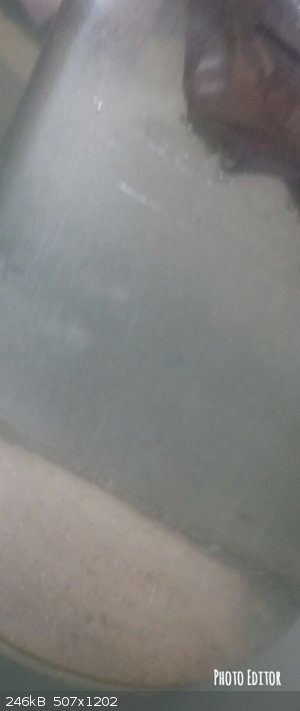
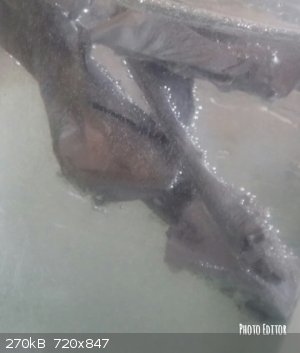
[Edited on 25-9-2018 by AJKOER]
|
|
|
AJKOER
Radically Dubious
    
Posts: 3026
Registered: 7-5-2011
Member Is Offline
Mood: No Mood
|
|
24 hours latter, more viscosity....
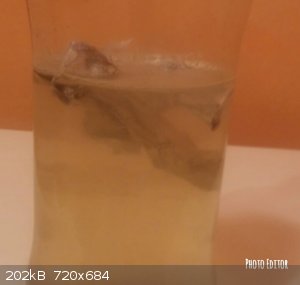
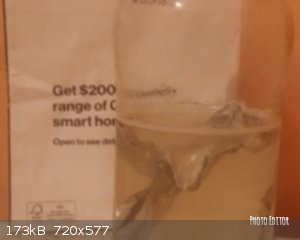
|
|
|
Loptr
International Hazard
    
Posts: 1347
Registered: 20-5-2014
Location: USA
Member Is Offline
Mood: Grateful
|
|
Is that aluminum foil?
"Question everything generally thought to be obvious." - Dieter Rams
|
|
|
AJKOER
Radically Dubious
    
Posts: 3026
Registered: 7-5-2011
Member Is Offline
Mood: No Mood
|
|
That is, indeed, aluminum foil that has been heated in a flame (in places till it is red).
Apparently, the heat treatment removes any protective coating and weakens the annealing process (which makes the Al foil seemingly inert). Here is an
extract of my prior comment on this topic:
Quote: Originally posted by AJKOER  | .....
I can across an excellent white paper (link https://www.google.com/url?sa=t&source=web&rct=j&... ) detailing reaction of Aluminum and water with promoters to address the
protective Al2O3 layer. To quote from page 7:
"It has been shown that mixtures of aluminum and aluminum oxide (Al2O3) powders are reactive with water in the pH range of 4-9 (11-13) and at
temperatures of 10-90 oC. These Al-Al2O3 powder mixtures must be heavily ball-milled together in order to produce hydrogen reactions. Hydrogen can
be evolved at room temperature using essentially neutral water, although the hydrogen evolution rate increases with increasing temperature. "
Also, to quote page 8: "The aluminum oxide may be in the form of bayerite (Al(OH)3), boehmite (AlO(OH)), gamma alumina (γ-Al2O3), or alpha alumina
(α-Al2O3). Alpha alumina powder was reported to give the maximum hydrogen evolution. It has been speculated that the milling of aluminum and aluminum
oxide powders together helps to mechanically disrupt the adherent and coherent oxide layers present on the aluminum powder, and that this is the
reason for the enhanced hydrogen generation in pH neutral water (11-13).
However, recent research has suggested that the enhancing effect of aluminum oxide on the reactivity of aluminum with water may also be
mechanochemical in nature (14). Aluminum powders that were reacted with fine boehmite powders at elevated temperatures produced a layer of
fine-grained, mechanically weak gamma alumina on the surfaces of the aluminum powders. "
Apparently weakened gamma alumina reacts as follows:
Induction Stage: Al2O3 + H2O ---) 2 AlOOH
Followed by:
6 AlOOH + 2 Al ----) 4 Al2O3 + 3 H2
leading to the rupturing of Aluminum oxide layer.
So, the burning of processed Al foil could produce some weaken gamma alumina as could occur also in the salt cake example. Given the moderate pH range
upon which the composition of Al and weakened gamma Al2O3 is subject to rupture per the above reactions, we have a tenative explanation of the
initialization reaction in the electrochemical setting.
[Edited on 23-6-2014 by AJKOER] |
[Edited on 25-9-2018 by AJKOER]
|
|
|
walruslover69
Hazard to Others
  
Posts: 216
Registered: 21-12-2017
Member Is Offline
Mood: No Mood
|
|
That is very interesting. I have read that SO4 radicals can be generated by Potassium Monopersulfate (Oxone) and cobalt ions.
https://pubs.acs.org/doi/10.1021/es050634b
Do you have any other plans besides transition metal amides and carbonates?
|
|
|
AJKOER
Radically Dubious
    
Posts: 3026
Registered: 7-5-2011
Member Is Offline
Mood: No Mood
|
|
Actually, I came across something related to the above upon thinking about the thread contents, which I am actually quite excited about it, owing in
part, to possible significant commercial value. I mention this as my further online explorations of other scenarios may be tempered until I pursue my
idea further.
Now, I know there are possible critics of this thread content, and I whole heartedly offer a welcome to even weakly based critical reviews
(seriously).
|
|
|
DJF90
International Hazard
    
Posts: 2266
Registered: 15-12-2007
Location: At the bench
Member Is Offline
Mood: No Mood
|
|
I think you need to run some control experiments in parallel. I would suggest identical mixtures but each excluding one of the following: a) NaCl, b)
H2O2, c) CO2, d) Fe and e) Al
Otherwise, your experiment tells you very little (due to all of the variables) and even though you're seeing reaction of the Al (and Fe?) it may not
be necessary to invoke radical processes to explain that. You might also want to trlest the reaction between dilute ferric chloride (a species that
can feasibly be formed under your reaction conditions) and Al to ascertain whether that may be the real cause of the reaction.
|
|
|
walruslover69
Hazard to Others
  
Posts: 216
Registered: 21-12-2017
Member Is Offline
Mood: No Mood
|
|
Doing the coppertetraamine sulfate synthesis would be a good proof of concept and the very bright purple color would be a good indicator instead of
waiting around. Copper(metal) + Oxone+ ammonia hydroxide?
The viscosity sounds like it could be due to Al(OH)3 owing to the fact that it is a common flocculent.
|
|
|
AJKOER
Radically Dubious
    
Posts: 3026
Registered: 7-5-2011
Member Is Offline
Mood: No Mood
|
|
Quote: Originally posted by DJF90  | I think you need to run some control experiments in parallel. I would suggest identical mixtures but each excluding one of the following: a) NaCl, b)
H2O2, c) CO2, d) Fe and e) Al
Otherwise, your experiment tells you very little (due to all of the variables) and even though you're seeing reaction of the Al (and Fe?) it may not
be necessary to invoke radical processes to explain that. You might also want to trlest the reaction between dilute ferric chloride (a species that
can feasibly be formed under your reaction conditions) and Al to ascertain whether that may be the real cause of the reaction. |
Completely agree!
However, as I have performed more experiments than I would like to admit involving Al foil that are just too sluggish, I was not really expecting
something that was so quickly evident.
The only exception is with a bleach battery composed of Al/Cu/8.25% NaOCl or acidified NaOCl, as compared here to Al/Fe/3% H2O2/H2CO3 in the presence
of a small amount of NaCl, which could still form small amounts of the chlorine radical and therefrom a much lower dose of HOCl.
[Edited on 25-9-2018 by AJKOER]
|
|
|
AJKOER
Radically Dubious
    
Posts: 3026
Registered: 7-5-2011
Member Is Offline
Mood: No Mood
|
|
Quote: Originally posted by walruslover69  | Doing the coppertetraamine sulfate synthesis would be a good proof of concept and the very bright purple color would be a good indicator instead of
waiting around. Copper(metal) + Oxone+ ammonia hydroxide?
The viscosity sounds like it could be due to Al(OH)3 owing to the fact that it is a common flocculent. |
Or, Copper(metal) + Oxone + a chloride which is a complexing agent for cuprous also.
Yes, Al(OH)3 is a possibility and with more time, it should be more evident.
Now, strangely, the whole solution appears uniformly to have higher viscosity with increasing cloudiness from a very fine whitish precipitate.
[Edited on 25-9-2018 by AJKOER]
|
|
|
walruslover69
Hazard to Others
  
Posts: 216
Registered: 21-12-2017
Member Is Offline
Mood: No Mood
|
|
Quote: Originally posted by AJKOER  |
Or, Copper(metal) + Oxone + a chloride which is a complexing agent for cuprous also.
[Edited on 25-9-2018 by AJKOER] |
Copper+oxone+chloride will probably give you a false positive if you are looking for a change in color as the proof of reaction.
The oxone would oxidize chloride to chlorine which would react and make your copper chloride and its complexes.
|
|
|
AJKOER
Radically Dubious
    
Posts: 3026
Registered: 7-5-2011
Member Is Offline
Mood: No Mood
|
|
Here is a point I would like to make per my cited article 'Radical-Enhanced Acidity: Why Bicarbonate, Carboxyl, Hydroperoxyl, and Related Radicals Are
So Acidic’, referring in particular, to the hydroperoxyl radical, •HO2, which arises in a Fenton reaction setting per the reaction sequence:
Fe(ll) = Fe(lll) + e-
O2 + e- = •O2-
H+ + •O2- = •HO2
Or, with H2O2 reaction sequence:
Fe(ll) = Fe(lll) + e-
H2O2 = H+ + HO2-
H+ + e-(aq) = •H
•H + HO2- = •OH + OH-
Net of last three reactions yields the more commonly cited reaction:
H2O2 + e-(aq) = •OH + OH-
And, finally, the formation of the acidic hydroperoxyl radical:
•OH + H2O2 = H2O + •HO2
It should be noted that in gas/aerosol conditions, the superoxide radical anion exists primarily as the acidic hydroperoxyl radical.
A work employing high pressure water jets to acidify a Fenton reaction without adding acid (see http://www.sciencemadness.org/talk/viewthread.php?tid=81667#... ) has already been explored by me on this forum.
[Edited on 25-9-2018 by AJKOER]
|
|
|
AJKOER
Radically Dubious
    
Posts: 3026
Registered: 7-5-2011
Member Is Offline
Mood: No Mood
|
|
Now, at 48 hours, a fluffy white precipitate visible. The aluminum foil displays only minor degradation.
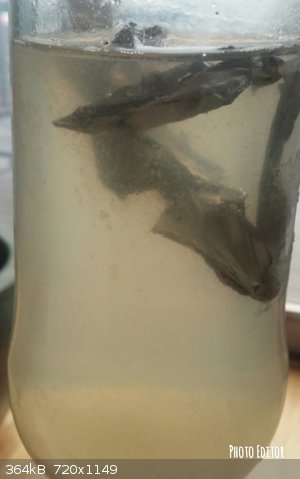
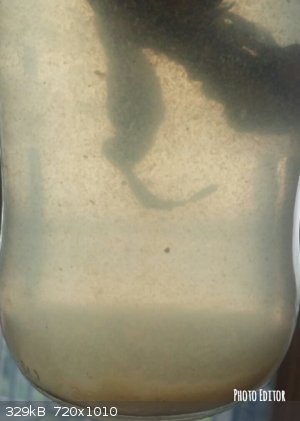
[Edited on 26-9-2018 by AJKOER]
|
|
|
AJKOER
Radically Dubious
    
Posts: 3026
Registered: 7-5-2011
Member Is Offline
Mood: No Mood
|
|
My thanks go to DJF90 for encouraging me to perform more runs with varying compositions.
Some very interesting results upon re-running the experiment leaving out a source for carbonate radical creation (no CO2/HCO3-).
First, I use the other half of my created flame treated Al foil to distilled water and added a bit of sea salt. Heated in a microwave for 2 minutes, a
picture shows no signs of any reaction. Added iron filings as before, reheated no reaction, but when I added 3% H2O2 to the hot solution instant
reaction forming a cloudy solution. In minutes, around the Al foil which resides at the top of the solution, a bright red zone (Fe(OH)3 ) develops and
growths, all without further heating of the solution. There was also large bubble formation (H2 is expected).
My take on the chemistry absence the presence of CO2/HCO3- (which scavengers the hydroxyl radical forming the carbonate radical) is as follows:
Al/Fe/H2O2 with some NaCl System:
-------------------------------------------------
Al --> Al(lll) + 3 e-
Fe --> Fe(ll) + 2 e-
e- + nH2O --> e-(aq)
H2O2 = H+ + HO2-
H+ + e-(aq) = •H
•H + HO2- = •OH + OH-
2 •OH + 2 e- (aq) --> 2 OH-
So: Fe + 2 •OH --> Fe(OH)2
Fe(ll) --> Fe(lll) + e-
•OH + e- (aq) --> OH-
So: Fe(ll)(OH)2 + •OH --> Fe(OH)3
And: Al + 3 •OH --> Al(OH)3
Also, related to hydrogen formation:
Al + 3 OH- --> Al(OH)3 + 3 e-
e- + nH2O --> e-(aq)
H2O = H+ + OH-
H+ + e-(aq) = •H
•H + •H --> H2 (g)
....
Pictures to follow.
[Edited on 26-9-2018 by AJKOER]
|
|
|
AJKOER
Radically Dubious
    
Posts: 3026
Registered: 7-5-2011
Member Is Offline
Mood: No Mood
|
|
Al/Fe/H2O2 with some NaCl System:
-------------------------------------------------
Picture on the far right is the pre-reaction mix without H2O2.
Note, the colored solution (without red) is likely ferrous rich and is formed quickly.
Per my reaction system outline above, the Fe(ll) is converted into red Fe(lll) in proximity to the anodic aluminum zone in the electrochemical cell.
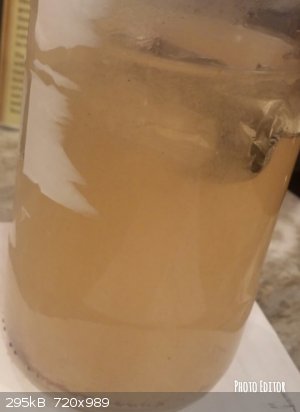 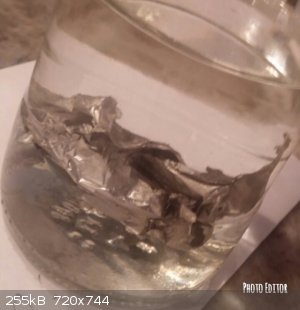
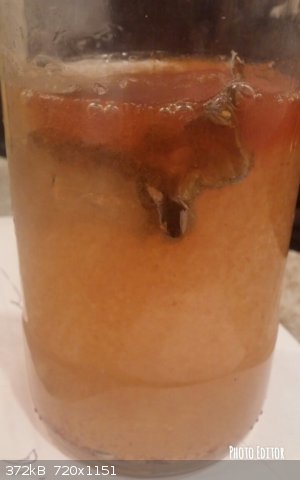
[Edited on 26-9-2018 by AJKOER]
|
|
|
AJKOER
Radically Dubious
    
Posts: 3026
Registered: 7-5-2011
Member Is Offline
Mood: No Mood
|
|
An interesting and important variation from my experimentation here for future work, is that one could substitute for carbonate, say a nitrate
especially aqueous NH4NO3, a possible nitration reaction could occur without any mineral acids required!
In particular, I have prepared NH4NO3 from adding ammonia water to Mg(NO3)2. The latter is formed from adding aqueous MgSO4 to 2 KNO3 and freezing out
the K2SO4.
My proposed (yet to be tested, read caution remark) additional chemistry here is as follows:
NH4NO3 (aq) = NH4+ + NO3-
NH4+ = H+ + NH3
H+ + e-(aq) = •H
•H + NH3 --> H2 (g) + •NH2
•NH2 + Fe(ll) + H+ = NH3 + Fe(lll)
•H + •H --> H2 (g) (which may remove some of the NH4+)
H2O2 + e(aq) = •OH + OH- (any OH- formed may also remove NH4+)
•OH + NO3- = OH- + •NO3
•H/•OH + RH (an organic) = H2/H2O + •R
•R + •NO3 = RNO3
and other products...
where small amounts of an organic nitrate/nitrite may be created.
Caution: many organic nitrates (like CH3NO3) are energetic (explosive), highly toxic, and possibly present significant long term health risk (even
from low doses).
Even if one is not intending to create such compounds, please be aware of the risks of working with a nitrate in the presence of an organic in
following my reaction path.
[Edited on 27-9-2018 by AJKOER]
|
|
|
Loptr
International Hazard
    
Posts: 1347
Registered: 20-5-2014
Location: USA
Member Is Offline
Mood: Grateful
|
|
Quote: Originally posted by AJKOER  | An interesting and important variation from my experimentation here for future work, is that one could substitute for carbonate, say a nitrate
especially aqueous NH4NO3, a possible nitration reaction could occur without any mineral acids required!
In particular, I have prepared NH4NO3 from adding ammonia water to Mg(NO3)2. The latter is formed from adding aqueous MgSO4 to 2 KNO3 and freezing out
the K2SO4.
My proposed (yet to be tested, read caution remark) additional chemistry here is as follows:
NH4NO3 (aq) = NH4+ + NO3-
NH4+ = H+ + NH3
H+ + e-(aq) = •H
•H + NH3 --> H2 (g) + •NH2
•NH2 + Fe(ll) + H+ = NH3 + Fe(lll)
•H + •H --> H2 (g) (which may remove some of the NH4+)
H2O2 + e(aq) = •OH + OH-
•OH + NO3- = OH- + •NO3
•H/•OH + RH (an organic) = H2/H2O + •R
•R + •NO3 = RNO3
and other products...
where small amounts of an organic nitrate/nitrite may be created.
Caution: many organic nitrates (like CH3NO3) are energetic (explosive), highly toxic, and possibly present significant long term health risk (even
from low doses).
Even if one is not intending to create such compounds, please be aware of the risks of working with a nitrate in the presence of an organic in
following my reaction path.
[Edited on 26-9-2018 by AJKOER] |
So are you saying this could be used to nitrate double bonds, such as those observed with styrene, etc.? Would an anti-Markovnikov addition be seen
due to radical mechanism?
"Question everything generally thought to be obvious." - Dieter Rams
|
|
|
AJKOER
Radically Dubious
    
Posts: 3026
Registered: 7-5-2011
Member Is Offline
Mood: No Mood
|
|
My comment, see 'The Reactivity of the Nitrate Radical (•NO3) in Aqueous and Organic Solutions', by
Stephen P. Mezyk, Thomas D. Cullen, Kimberly A. Rickman and Bruce J. Mincher, per the abstract to quote:
"ABSTRACT
Rate constants for the nitrate (•NO3) radical reaction with alcohols, alkanes, alkenes, and several aromatic compounds were measured in aqueous and
tert‐butanol solution for comparison to aqueous and acetonitrile values from the literature. The measured trends provide insight into the reactions
of the •NO3 radical in various media. The reaction with alcohols primarily consists of hydrogen‐atom abstraction from the alpha‐hydroxy position
and is faster in solvents of lower polarity where the diffusivity of the radical is greater. Alkenes react faster than alkanes, and their rate
constants are also faster in nonpolar solution. The situation is reversed for the nitrate radical reaction with the aromatic compounds, where the rate
constants in tert‐butanol are slower. This is attributed to the need to solvate the NO3− anion and corresponding tropylium cation produced by the
•NO3 radical electron transfer reaction. A linear correlation was found between measured rate constants in water and acetonitrile, which can be used
to estimate aqueous nitrate radical rate constants for compounds having low water solubility."
So perhaps in a particular application, the nitrate radical is faster or may be its slower, but may be always inexpensively available. And, if sourced
from KNO3, it is also safe and seemingly innocuous. But all this, of course, rests on my proposed path actually working . .
[Edited on 27-9-2018 by AJKOER]
|
|
|
AJKOER
Radically Dubious
    
Posts: 3026
Registered: 7-5-2011
Member Is Offline
Mood: No Mood
|
|
Here is a side by side reaction results:
The carbonate radical treated solution (on the right) may have indeed created a carbonate salt, looks like FeCO3, but I will test. It is fluffy and a
bit off-white, not resembling Al(OH)3, in my opinion, which is in accord with the largely untarnished appearance of the Al foil.
The carbonate-free run (on the left) appears to have created a reddish fluffy precipitate suggesting a ferric ion. The Al foil has lost most of its
luster.
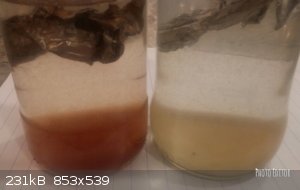
[Edited on 27-9-2018 by AJKOER]
|
|
|
AJKOER
Radically Dubious
    
Posts: 3026
Registered: 7-5-2011
Member Is Offline
Mood: No Mood
|
|
Interestingly, my simple galvanic cell (consisting of Fe|Al metals and an electrolyte of sea salt) plus 3% H2O2 (usually with an acidic stabilizer,
which also forms ions with the metals) as a path to hydroxyl radicals for synthesis is included, and similarly discussed, in a 1999 U.S. Patent
6,692,632 at https://patents.google.com/patent/US6692632 . To quote parts:
First, as to my choice of employing an electrochemical cell for synthesis:
"The method is preferably used in synthesis, but can also be useful in the destruction of pollutants etc. In certain embodiments of this nature, the
use of external current applied to the system is not necessary, and a simple galvanic cell can be set up."
"In a preferred embodiment the present invention provides a method of chemically synthesising a reaction product from reactants, said method
comprising the following steps:
a) electrochemically forming Fe2+ ions;
b) exposing said Fe2+ ions to H2O2 to produce HO*;
c) exposing said HO* to the reactants in conditions suitable for said HO* and said reactants to chemically react together to promote formation of said
reaction product."
where I replace " exposing said Fe2+ ions to H2O2 to produce HO* " with equivalent reactions in the presence of an electrolyte, Fe(ll) --> Fe(lll)
+ e- and e-(aq) + H2O2--> *OH + OH- , producing the Fenton products.
Also, "Fe2+ ions are preferably generated through electrochemical dissolution of an iron anode in electrolytes of ....", whereas, in my embodiment, I
use, as noted above, a galvanic cell and the iron anode is an anodic zone of iron particles.
Lastly, "Alternatively the method may comprise generating the hydroxyl radicals by reacting the metal with hydrogen peroxide by the following
equation:
M+H2O2→HO*+HO−+Mn++(n−1)e−
wherein M is Fe or another metal and n is any value from 1 to 7.", where I also employ starting metals (Fe and Al).
I would also note that the underlying presence of an encompassing commercial patent apparently supporting my suggested path, or at least a variation
thereof, may indicate more than just theoretical interest.
[Edited on 27-9-2018 by AJKOER]
|
|
|
AJKOER
Radically Dubious
    
Posts: 3026
Registered: 7-5-2011
Member Is Offline
Mood: No Mood
|
|
My simple analysis of the products of the Al/Fe/HCO3-/H2O2 with some NaCl system suggests that the product is a mix of Al(OH)3, AlO(OH) and possibly,
a very small amount of a carbonate due to some visible CO2 upon adding dilute acetic acid and heating.
My assessment is that the products are likely consistent with the reference I cited. To repeat:
"“The composition of the precipitate obtained from solutions of an aluminium salt and an alkali carbonate varies with the concentrations of the
reagents, nature of the aluminium salt, temperature of precipitation, etc. The normal carbonate is never obtained, the precipitates being composed
largely of aluminium hydroxide, with smaller quantities of aluminium carbonate, basic aluminium salts, and alkali carbonate.”
[Edited on 28-9-2018 by AJKOER]
|
|
|
DraconicAcid
International Hazard
    
Posts: 4278
Registered: 1-2-2013
Location: The tiniest college campus ever....
Member Is Offline
Mood: Semi-victorious.
|
|
Quote: Originally posted by AJKOER  | My simple analysis of the products of the Al/Fe/HCO3-/H2O2 with some NaCl system suggests that the product is a mix of Al(OH)3, AlO(OH) and possibly,
a very small amount of a carbonate due to some visible CO2 upon adding dilute acetic acid and heating.
My assessment is that the products are likely consistent with the reference I cited. |
And that's exactly what you would expect to get, whether it follows the radical mechanism that you've dreamed up, or a simple one.
Please remember: "Filtrate" is not a verb.
Write up your lab reports the way your instructor wants them, not the way your ex-instructor wants them.
|
|
|
AJKOER
Radically Dubious
    
Posts: 3026
Registered: 7-5-2011
Member Is Offline
Mood: No Mood
|
|
Quote: Originally posted by DraconicAcid  |
.....
And that's exactly what you would expect to get, whether it follows the radical mechanism that you've dreamed up, or a simple one.
|
Thanks for reading my thread!
However, with respect to my alleged creativity in the present case, per my opening thread the interaction of metal ions and say, the sulfate radical,
can actually form, per my cited source, a sulfate (or a carbonate). To quote again:
"p. 15 reported reactions by •SO4- acting on Fe(ll), Ce(lll), Cr(ll),.. at https://srd.nist.gov/NSRDS/NSRDS-NBS-65.pdf by Ross and Neta) "
With respect to the carbonate radical, there are also listed reaction rates between •CO3- acting on Co(ll), Cu(ll), Mn(ll), Ni(ll),...
[Edited on 28-9-2018 by AJKOER]
|
|
|
DraconicAcid
International Hazard
    
Posts: 4278
Registered: 1-2-2013
Location: The tiniest college campus ever....
Member Is Offline
Mood: Semi-victorious.
|
|
Yes, we know that radicals like SO4(-) can react with metals. But that doesn't mean that a reaction with metal signifies the presence of a radical.
Please remember: "Filtrate" is not a verb.
Write up your lab reports the way your instructor wants them, not the way your ex-instructor wants them.
|
|
|
| Pages:
1
2 |